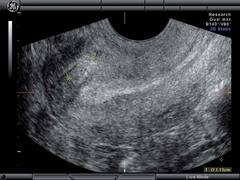Cases & Papers
Ultrasound in Benign Gynaecology
 BACKGROUND
BACKGROUNDWhat is Ultrasound?
Ultrasound is an imaging technique based upon the generation and subsequent capture, analysis, and display of vibroacoustic sound waves reflected from internal structures and surface interfaces.
Sound waves have two main characteristics: frequency and amplitude. The velocity of sound waves in human tissue is constant at 1540 m/s and is determined by the wavelength and frequency such that high frequency sound waves characteristically have a shorter wavelength (velocity = wavelength x frequency). Frequency is a measure of the amount of vibrations, or single wavelengths, that occur in one second and is measured in Hertz (Hz). Audible frequencies occur in a range of 20 Hz to 20,000 Hz and the term "ultrasound" simply refers to sound waves that are inaudible to the human ear.
Ultrasound transducers are usually in the range of 2-10 megahertz (MHz) with higher frequency transducers providing better resolution and image quality but at the expense of attenuation, or reduced penetration. Transvaginal ultrasound typically uses higher frequency probes than transabdominal ultrasound, as the organs of interest are nearer the transducer, and provides more information and improved definition as a result. Transvaginal pelvic assessment should always be performed in conjunction with transabdominal ultrasound, however, as the limited penetration and field of view may mean a large mass, such an ovarian cyst or serosal fibroid, is missed.
Author:
Dr. N.J. Raine-FENNING
Consultant Gynaecologist & Clinical Senior Lecturer
in Reproductive Medicine
Academic Division of Reproductive Medicine
Nottingham University
